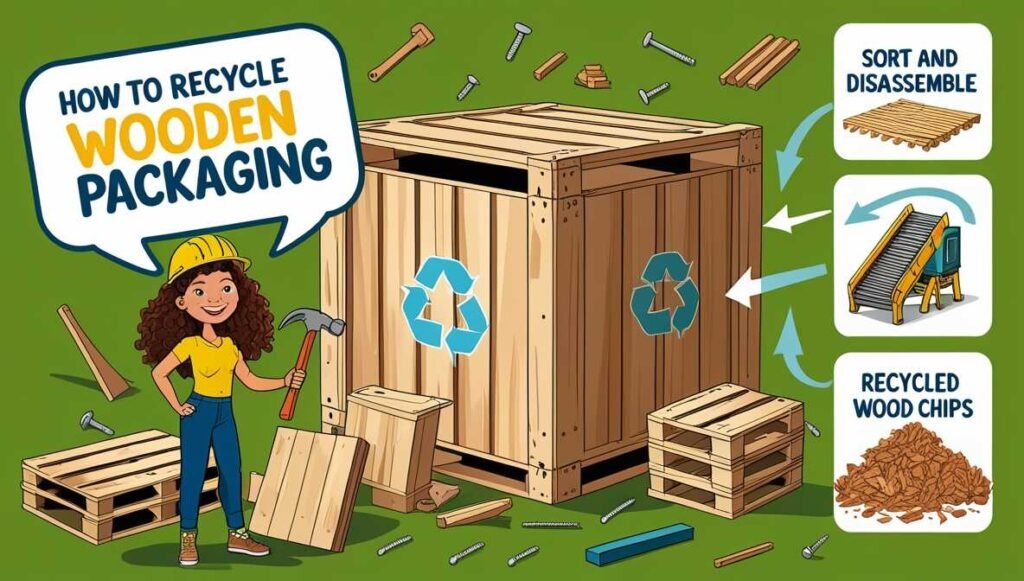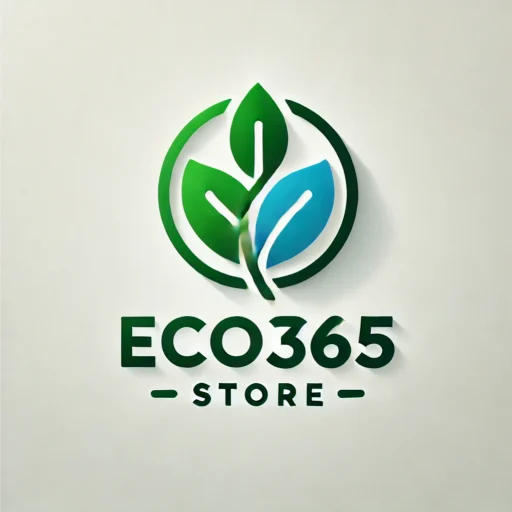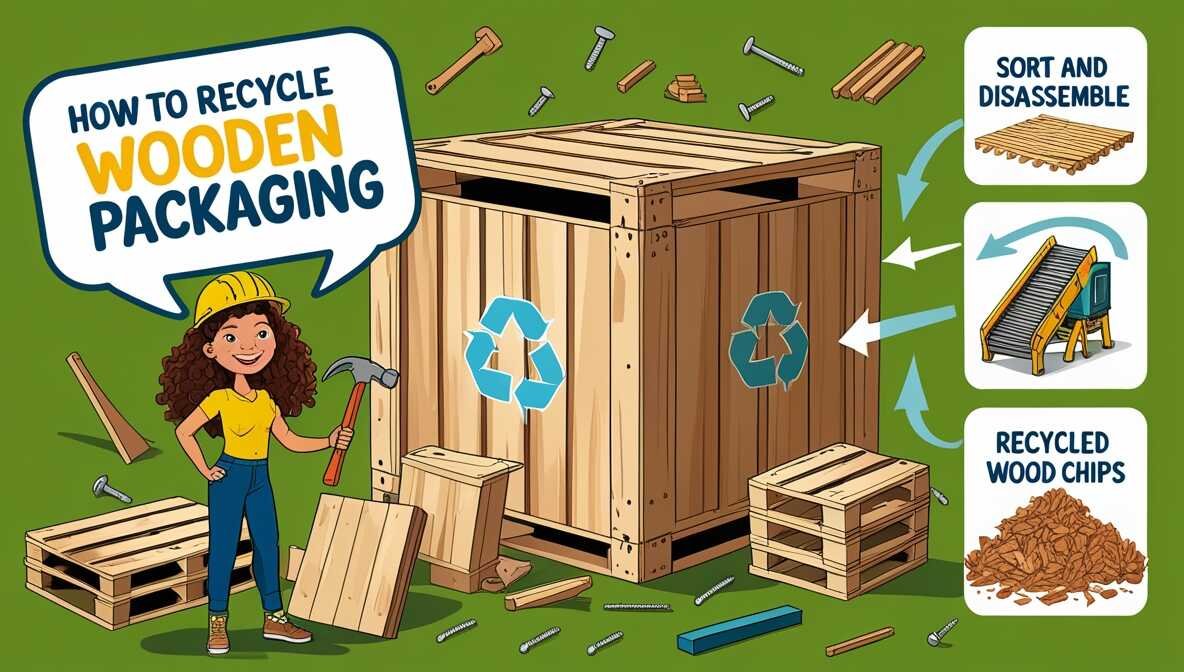Did you know that millions of wooden crates, pallets, and boxes are discarded every year, contributing significantly to landfill waste? While wooden packaging is durable and versatile, improper disposal can harm the environment. Fortunately, learning how to recycle wooden packaging can help conserve resources, reduce packaging waste, and even create opportunities for reuse and upcycling.
This article will provide a step-by-step guide on the best ways to recycle wood from packaging materials like pallets, crates, and boxes. Along the way, we’ll explore how recycling helps minimize the use of cardboard, plastic, and other non-biodegradable materials. Let’s turn waste into resources and keep our planet clean and green!

Why Recycle Wood Packaging?
Recycling wooden packaging is more than just a sustainable choice—it’s a necessity to protect our environment and conserve natural resources. Here’s why it matters:
1. Environmental Impact
Discarding wood packaging like pallets, crates, and boxes into landfills contributes to significant environmental harm. When untreated wood decomposes, it releases greenhouse gases such as methane, worsening climate change. Additionally, dumping scrap wood increases landfill waste, taking up valuable space that could otherwise be used for recyclable materials.
By recycling, you can give this wood a second life, reducing the need to dispose of it irresponsibly. Recycled wood can be repurposed for use in landscaping, creating mulch, or even as raw materials for new products, minimizing the demand for deforestation.
2. Resource Conservation
Recycling wood packaging helps conserve trees, which are a vital resource for maintaining ecological balance. Recycled wood can be sorted and repurposed into useful items like wood pellets, mulch, or even particleboard, reducing the need to cut down more trees.
When you recycle or reuse scrap wood, you not only save valuable resources but also contribute to a more sustainable economy. Properly sorted and treated wood packaging is fully recyclable, ensuring it becomes part of a circular system instead of contributing to waste.
The Benefits of Recycling Wooden Packaging
- Protects forests by reducing deforestation.
- Prevents landfill overcrowding and reduces harmful emissions.
- Creates eco-friendly alternatives like landscape mulch and particleboard.
- Promotes a sustainable approach to managing resources.
Recycling wooden packaging isn’t just an environmentally responsible choice—it’s a step toward a cleaner, greener future. Let’s turn scrap wood into valuable resources and protect the planet, one crate at a time!

Preparing Wooden Packaging for Recycling
Recycling wooden packaging, such as pallets, crates, and boxes, requires careful preparation to ensure safety and efficiency. By following these steps, you can make the recycling process smoother and more effective.
1. Removal of Contaminants
a. Remove nails, staples, and other metal hardware
- Before recycling, inspect the wood for nails, screws, staples, or other metal components.
- Use tools like pliers or a hammer to carefully extract these items.
- Why it matters: Removing hardware prevents damage to recycling equipment and ensures safety during handling and processing.
b. Clean the wood
- Wipe or wash the wood to remove dirt, debris, and any leftover product residue.
- Avoid using harsh chemicals during cleaning, especially if the wood will be repurposed for landscape mulch or other eco-friendly uses.
- Why it matters: Clean wood is easier to process and can be used for higher-quality recycled products.
2. Sorting Wood Types
a. Separate different types of wood
- If possible, categorize softwood and hardwood packaging materials, as they may have different recycling or repurposing applications.
- Softwood is commonly used for pallets and crates, while hardwood is more durable and may be repurposed for furniture or construction.
b. Why sorting matters
- Efficient sorting enhances recycling processes and ensures the wood is repurposed effectively.
- Recyclers can create specialized products like particleboard, wood pellets, or high-quality mulch by processing specific wood types separately.
How To Recycle Wooden Packaging?
Finding the best way to recycle wooden packaging can make a big difference in reducing waste and protecting the environment. Here are some practical options to ensure your wood packaging is responsibly recycled or repurposed.
1. Local Recycling Centers
a. Check with your local municipality
- Start by reaching out to your local government or waste management service to learn about recycling guidelines for wooden packaging. Some areas may have specific programs for wood waste.
b. Curbside recycling
- While most curbside recycling programs don’t accept wooden packaging like crates or pallets, it’s worth checking with your service provider. If they don’t accept wood, they may guide you to other options.
c. Drop-off centers
- Many areas have local drop-off centers that accept wood waste. Look for facilities that specifically handle scrap wood or wood packaging, ensuring it gets recycled into products like mulch or particleboard.
2. Wood Recycling Companies
a. Find local companies
- Search online or in directories for wood recycling companies in your area. These businesses specialize in processing wood waste and can help you responsibly dispose of your materials.
b. Services offered
- Wood recycling companies often provide services like wood chipping, shredding, or turning wood into compost or mulch for landscaping. Some even create wood pellets or fuel for energy production.
3. DIY Wood Projects
a. Upcycling ideas
Get creative and reuse wooden packaging for practical or decorative purposes! Here are a few ideas:
- Garden structures: Turn wooden pallets into planters, compost bins, or trellises.
- Home crafts: Create rustic furniture, wall art, or storage solutions using wood crates and pallets.
- Firewood: If the wood is untreated and safe to burn, use it for campfires or as kindling for heating.
Choose What Works Best
Whether you’re dropping off your wood packaging at a local recycling center, working with a wood recycling company, or getting creative with DIY projects, recycling wooden packaging is easier than you think. Explore these options and help turn waste into valuable resources while protecting the planet!
Tips for Reducing Wooden Packaging Waste
Minimizing wooden packaging waste is a great way to support sustainability and reduce environmental impact. Here are some practical tips to make a difference:
1. Choose Sustainable Packaging
- Support eco-friendly businesses: Opt for companies that use sustainable materials like recycled cardboard or biodegradable packaging instead of wood.
- Look for certifications: Choose products with eco-certifications to ensure responsible sourcing and minimal environmental impact.
2. Reuse Wooden Packaging Whenever Possible
- Get creative: Turn wooden pallets into furniture, crates into storage solutions, or boxes into garden planters.
- Extend their use: Wooden packaging can be reused multiple times in homes or businesses for storage, transportation, or decorative purposes.
- Why reuse matters: Reusing reduces the demand for new packaging and keeps valuable materials out of landfills.
3. Reduce Packaging Waste
- Buy in bulk: Purchasing products in larger quantities reduces the need for excessive packaging.
- Choose minimal packaging: Opt for products with minimal or no packaging to reduce waste from the start.
- Encourage suppliers: Work with vendors and suppliers to adopt greener practices, like using recyclable materials or reducing unnecessary packaging.
Small Steps, Big Impact
By choosing sustainable packaging, reusing wooden materials, and reducing waste through smarter purchasing decisions, you can play a key role in reducing wooden packaging waste. These simple practices not only conserve resources but also create a cleaner and greener planet for everyone.
Conclusion: Making a Difference by Recycling Wooden Packaging
Recycling wooden packaging is an essential step toward protecting our environment and conserving valuable resources. By learning how to recycle wooden packaging, we can reduce waste, minimize landfill usage, and give new life to materials like crates, pallets, and boxes.
The process is simple yet impactful: prepare the wood by removing contaminants, clean and sort it, and explore options like local recycling centers, wood recycling companies, or creative DIY projects. Each small effort contributes to a greener and more sustainable planet.
Now it’s your turn—take action today! Embrace recycling and help turn wooden packaging waste into a valuable resource for a brighter future.
Can wooden packaging be recycled?
Yes, wooden packaging like pallets, crates, and boxes can be recycled. Many recycling centers and wood recycling companies accept untreated wood for repurposing into products like mulch, particleboard, or wood pellets.
Can I reuse wooden packaging instead of recycling it?
Absolutely! Wooden packaging can be repurposed for DIY projects like garden planters, furniture, storage solutions, or even firewood if the wood is untreated. Reusing is a great way to reduce waste and extend the life of the material.
Are all types of wooden packaging recyclable?
Untreated wood is the easiest to recycle. However, wood that has been painted, varnished, or chemically treated may not be accepted by some recycling facilities due to potential contaminants. Always check with your local recycler for specific guidelines.

Anamika is a passionate writer for Eco365Store.com, specializing in topics that inspire a cleaner, greener world. With expertise in home cleaning, recycling, and eco-friendly solutions, she crafts engaging and informative articles that help readers adopt sustainable practices in their daily lives.

